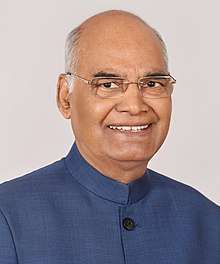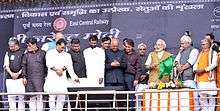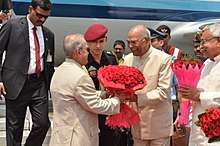Ram Nath Kovind
| His Excellency Ram Nath Kovind | |
|---|---|
 | |
| 14th President of India | |
|
Assumed office 25 July 2017 | |
| Prime Minister | Narendra Modi |
| Vice President |
Mohammad Hamid Ansari Venkaiah Naidu |
| Preceded by | Pranab Mukherjee |
| Governor of Bihar | |
|
In office 16 August 2015 – 20 June 2017 | |
| Chief Minister | Nitish Kumar |
| Preceded by | Keshari Nath Tripathi |
| Succeeded by | Keshari Nath Tripathi |
| Personal details | |
| Born |
1 October 1945 Paraunkh, United Provinces, British India |
| Political party | BJP |
| Spouse(s) | |
| Residence | Rashtrapati Bhavan |
| Alma mater | Kanpur University |
Ram Nath Kovind (born 1 October 1945) is the 14th and current President of India, in office since 25 July 2017.[1] Previously he had served as the Governor of Bihar from 2015 to 2017[2][3] and was a Member of Parliament, Rajya Sabha from 1994 to 2006. Kovind was nominated as a presidential candidate by the ruling NDA coalition and won the 2017 presidential election, becoming the second Dalit to be elected to the post of President.[4]
Before entering politics, he was a lawyer for 16 years and practiced in the Delhi High Court and the Supreme Court until 1993.[5]
Early life and education
Kovind was born on 1 October 1945 in Paraukh village in the Kanpur Dehat district, Uttar Pradesh.[6][7] His father Maikulal ran a small shop to support his family. He was the youngest of five brothers and two sisters. He was born in a mud hut, which eventually collapsed. He was only five when his mother died of burns when their thatched dwelling caught fire. Kovind later donated the land to the community.[8]
After his elementary school education, he had to walk each day to Kanpur village, 8 km away, to attend junior school, as nobody in the village had a bicycle.[9] He holds a bachelor's degree in commerce and an LLB from DAV College (affiliated with Kanpur University).[10][11][6]
Career

Advocate
After graduating in law from DAV College, Kanpur, Kovind went to Delhi to prepare for the civil services examination. He passed this exam on his third attempt, but he did not join because he had only scored high enough to work in an allied service rather than of IAS and thus started practicing law.[12]
Kovind enrolled as an advocate in 1971 with the bar council of Delhi. He was Central Government Advocate in the Delhi High Court from year 1977 to year 1979. Between 1977 & 1978, he also served as the personal assistant of Prime Minister of India Morarji Desai.[13] In 1978, he became an advocate-on-record of the Supreme Court of India and served as a standing counsel for the Central Government in the Supreme Court of India from 1980 to 1993. He practiced in the Delhi High Court and Supreme Court until 1993. As an advocate, he provided pro-bono aid to weaker sections of society, women and the poor under the Free Legal Aid Society of New Delhi.[10]
BJP member
He joined the BJP in 1991.[13] He was President of the BJP Dalit Morcha between 1998 and 2002 and President of the All-India Koli Samaj. He also served as national spokesperson of the party.[14] He donated his ancestral home in Derapur to the RSS.[13] Soon after joining the BJP, he contested for Ghatampur assembly constituency, but lost and later contested for Bhognipur (in 2007) (both in Uttar Pradesh) assembly constituency on the BJP ticket but lost again.[15]
In 1997, Kovind joined the protest against certain orders from the Central government that had adverse effects on the SC/ST workers. Later, three amendments were made to the Constitution that revoked the orders, by the NDA government headed by Atal Bihari Vajpayee.[16]
Rajya Sabha
He was elected and became a Rajya Sabha MP from the state of Uttar Pradesh in April 1994. He served a total of twelve years, two consecutive terms, until March 2006. As a member of parliament, he served on the Parliamentary Committee for Welfare of Scheduled Castes/Tribes, Home Affairs, Petroleum and Natural Gas, Social Justice and Empowerment, Law and Justice. He also served as the chairman of the Rajya Sabha House Committee. During his career as a parliamentarian, under the Members of Parliament Local Area Development Scheme, he focused on education in rural areas by helping in construction of school buildings in Uttar Pradesh and Uttrakhand. As a member of parliament, he visited Thailand, Nepal, Pakistan, Singapore, Germany, Switzerland, France, the United Kingdom and the United States on study tours.[11]
Other appointments
He has served on the Board of management of Dr. B.R Ambedkar University, Lucknow, and as on the Board of Governors of IIM Calcutta. He has also represented India at the UN and addressed the United Nations General Assembly in October 2002.[17]
Governor
On 8 August 2015, the then President of India appointed Kovind as Governor of Bihar.[18] On 16 August 2015, the acting Chief Justice of Patna High Court, Iqbal Ahmad Ansari, administered the oath to Kovind as the 35th Governor of Bihar. The function took place at Raj Bhawan, Patna.[19]

Kovind's appointment was criticised by then Chief Minister of Bihar Nitish Kumar as it came months before State Assembly elections and the appointment was made without consulting State Government as recommended by Sarkaria Commission.[20] However, Kovind's term as Governor, was praised for constituting a judicial commission to investigate irregularities in promotion of undeserving teachers, mis-management of funds and appointment of undeserving candidates in universities.[13] In June 2017, when Kovind was announced as candidate for Presidential election, Nitish Kumar backed Kovind's choice and praised Kovind as being unbiased and working closely with the State Government during his Governorship.[21]
2017 presidency campaign
After nomination for the post of 14th President of India, he resigned from his post as Governor of Bihar, and President of India Pranab Mukherjee accepted his resignation on 20 June 2017.[22] He won election on 20 July 2017.[23]
Ram Nath Kovind received 65.65% of the valid votes, against former Speaker of the Lok Sabha - Meira Kumar, the presidential candidate of the Opposition who received 34.35% of the total votes. Kovind received 2,930 votes (From MPs and MLAs) amounting to Electoral College votes of 702,044 (65.65%) as compared to 1,844 votes with a value of 367,314 (34.35%) votes for Meira Kumar lagging far behind with 367,314 votes, and 77 votes were invalid.[24] He became only the second Dalit representative to become President after K. R. Narayanan, and also is the first BJP candidate to be elected to the post.[25] The tally of votes (367,314) polled by Meira Kumar is only the second highest for a losing candidate, that of Neelam Sanjiva Reddy in the 1969 Presidential elections being the highest ever; he received 405,427 votes as against 420,077 by V V Giri, the winner.

14th President of India
Ram Nath Kovind took the oath as the 14th President of India on 25 July 2017.[26]
List of international trips as president
| Country | Areas Visited | Date(s) | Purpose | References |
|---|---|---|---|---|
| 2017 | ||||
| Djibouti City | 3 - 4 October | State Visit | [27][28] | |
| Addis Ababa | 5 - 6 October | [29][30][31] | ||
| 2018 | ||||
| Port Louis | 11 - 14 March | State Visit | [32][33] | |
| Antananarivo | 14 - 15 March | [32] | ||
| Malabo | 7 - 9 April | [34] | ||
| Mbabane | 9 - 10 April | [35] | ||
| Lusaka | 10 - 12 April | [36][37] | ||
| Athens | 16 - 19 June | [38][39] | ||
| Paramaribo | 19 - 21 June | [39][40] | ||
| Havana | 21 - 23 June | [41][42] | ||
| Nicosia | 2 - 4 September | [43] | ||
| Sofia | 4 - 6 September | [44] | ||
| Prague | 6 - 9 September | [45] | ||
Personal life
Kovind married Savita Kovind on 30 May 1974. They have a son, Prashant Kumar, and a daughter, Swati.[6]
Controversy
In 2010, he was reported to have said that "Islam and Christianity are alien to the nation" as spokesperson of the BJP.[46][47] As reported by IANS and published by Hindustan Times, he made this comment in response to the Ranganath Misra Commission which recommended 15 percent reservation for religious and linguistic minorities in government jobs.[48] Although more recently, the issue was raised in the media if whether or not he was misquoted and that he in fact said “Islam and Christianity are alien to the notion (of caste)” as opposed to what was reported as "nation".[49][50]
References
- ↑ "Ram Nath Kovind takes oath: In inaugural speech, president outlines vision for India as world leader". Firstpost. 25 July 2017. Archived from the original on 2 August 2017. Retrieved 2 August 2017.
- ↑ "Press Releases Detail – The President of India". presidentofindia.nic.in. Archived from the original on 27 August 2017.
- ↑ Ram Nath Kovind resigns as Bihar Governor (20 June 2017). "Ram Nath Kovind resigns as Bihar Governor". The Hindu. Archived from the original on 8 October 2017. Retrieved 20 June 2017.
- ↑ CNN, Huizhong Wu (20 July 2017). "Man from India's lowest caste elected president". CNN. Archived from the original on 21 July 2017.
- ↑ "Bihar Governor Ram Nath Kovind is NDA nominee for President". The Hindu. The Hindu. 19 June 2017. Archived from the original on 24 June 2017. Retrieved 23 July 2017.
- 1 2 3 "Governor of Bihar". governor.bih.nic.in. Archived from the original on 3 July 2017. Retrieved 20 June 2017.
- ↑ "Ram Nath Kovind, Paraukh and the road to Raisina Hill". Archived from the original on 27 August 2017. Retrieved 24 August 2017.
- ↑ "कानपुर से ग्राउंड रिपोर्ट : रामनाथ कोविंद के गांव में जश्न, लोग गा रहे हैं- मेरे बाबा की भई सरकार". Archived from the original on 21 July 2017. Retrieved 24 August 2017.
- ↑ Tiwari, Vaibhav (20 June 2017). "NDA Presidential nominee Ram Nath Kovind would walk 8 km daily for school". India.com. Archived from the original on 30 July 2017. Retrieved 25 July 2017.
- 1 2 PTI (19 June 2017). "Ram Nath Kovind: A crusader for the rights of weaker sections". The Economic Times. Archived from the original on 27 August 2017. Retrieved 19 June 2017.
- 1 2 "Bihar governor Ram Nath Kovind: 10 facts about NDA's Presidential nominee – Times of India". The Times of India. Archived from the original on 27 August 2017. Retrieved 19 June 2017.
- ↑ PTI (19 June 2017). "What you should know about BJP's presidential candidate Ram Nath Kovind". Archived from the original on 18 July 2017 – via The Economic Times.
- 1 2 3 4 "Ram Nath Kovind, a lawyer who cracked civils but lost 2 elections – Times of India". The Times of India. Archived from the original on 18 July 2017. Retrieved 20 June 2017.
- ↑ "Enact tougher laws to prevent crimes against dalits". The Hindu. Archived from the original on 4 October 2011.
- ↑ "Ram Nath Kovind, a lawyer who cracked civils but lost 2 elections". Times of India. 20 June 2017. Archived from the original on 18 July 2017. Retrieved 24 July 2017.
- ↑ "Ram Nath Kovind is BJP's choice for president: All you need to know about the Dalit leader from UP". Firstpost. 20 July 2017. Archived from the original on 24 July 2017.
- ↑ "Ramnath Kovind Profile". Outlook. 19 June 2017. Archived from the original on 27 August 2017. Retrieved 20 June 2017.
- ↑ PTI (8 August 2015). "Ram Nath Kovind, Acharya Dev Vrat appointed as Bihar and Himachal Pradesh governors". Archived from the original on 27 August 2017 – via The Economic Times.
- ↑ "36th Governor of Bihar". indiatoday. 16 August 2015. Archived from the original on 17 August 2015. Retrieved 16 August 2015.
- ↑ PTI (19 August 2015). "PM Modi praises new Bihar Governor Ram Nath Kovind". Archived from the original on 27 August 2017 – via India TV News.
- ↑ IANS (19 June 2017). "Presidential Election 2017: Nitish Kumar praises Ram Nath Kovind, remains mum on party support". Archived from the original on 29 July 2017 – via First Post.
- ↑ "Resignation as Governor of Bihar". firstpost. 20 August 2015. Archived from the original on 27 August 2017. Retrieved 20 August 2015.
- ↑ "Ram Nath Kovind is the 14th President of India". The Hindu. Archived from the original on 20 July 2017. Retrieved 20 July 2017.
- ↑ "With 65 percent votes, Kovind sweeps elections". Times of India. 21 July 2017. Archived from the original on 21 July 2017.
- ↑ "Kovind first President from Sangh, cross-voting boosts margin". Times of India. 21 July 2017. Archived from the original on 23 July 2017. Retrieved 23 July 2017.
- ↑ "Ram Nath Kovind takes oath as India's 14th President". indtoday.com. 25 July 2017. Archived from the original on 28 July 2017.
- ↑ "Press Information Bureau". Archived from the original on 5 October 2017. Retrieved 4 October 2017.
- ↑ "Press Information Bureau". Archived from the original on 5 October 2017. Retrieved 4 October 2017.
- ↑ "Press Information Bureau". Archived from the original on 6 October 2017. Retrieved 5 October 2017.
- ↑ "Press Information Bureau". Archived from the original on 6 October 2017. Retrieved 5 October 2017.
- ↑ "Press Information Bureau". Archived from the original on 6 October 2017. Retrieved 5 October 2017.
- 1 2 "President Kovind meets Mauritius counterpart in Port Louis | DD News". www.ddinews.gov.in. Retrieved 2018-03-12.
- ↑ "President of India reached Mauritius; Addresses students at Mahatma Gandhi Institute; says India's aspiration is for Mauritius to rise as a leading Economy and a voice for peace and stability in the entire Indian Ocean Region". pib.nic.in. Retrieved 2018-03-12.
- ↑ Roche, Elizabeth (2018-04-05). "President Ram Nath Kovind to visit Africa in bid to bolster ties". https://www.livemint.com/. Retrieved 2018-04-13. External link in
|work=(help) - ↑ "President Ram Nath Kovind to reach Swaziland today". The Financial Express. 2018-04-09. Retrieved 2018-04-13.
- ↑ Chaudhury, Dipanjan Roy (2018-04-05). "President Ram Nath Kovind embarks on third official foreign trip". The Economic Times. Retrieved 2018-04-13.
- ↑ "President Kovind arrives in Lusaka, accorded ceremonial reception". www.aninews.in. Retrieved 2018-04-13.
- ↑ "President Kovind in Greece; Addresses Indian Community in Greece; Urges Indian Community in Greece to Help Enhance Economic, Cultural and People-to-People Links between the two Countries". Retrieved 2018-07-11.
- 1 2 "President Kovind leaves on 3-nation visit to Greece, Suriname, Cuba - Times of India". The Times of India. Retrieved 2018-07-11.
- ↑ "Address by the Hon'ble President Of India Shri Ram Nath Kovind on the occasion of the International Day of Yoga celebrations in Suriname". pib.nic.in. Retrieved 2018-07-11.
- ↑ "President of India in Cuba, pays tributes to National Heroes of Cuba to address students at University of Havana". pib.nic.in. Retrieved 2018-07-11.
- ↑ "President Ram Nath Kovind to visit Greece, Suriname, Cuba". The New Indian Express. Retrieved 2018-07-11.
- ↑ "Ram Nath Kovind embarks on 3-nation tour". The New Indian Express.
- ↑ "Ram Nath Kovind embarks on 3-nation tour". The New Indian Express.
- ↑ "Ram Nath Kovind embarks on 3-nation tour". The New Indian Express.
- ↑ "Why is India's next president so unknown?". BBC. Archived from the original on 21 July 2017. Retrieved 20 July 2017.
- ↑ "When NDA Presidential pick Kovind said Islam, Christianity are alien to India". The New Indian Express. Archived from the original on 28 July 2017. Retrieved 20 July 2017.
- ↑ "Islam, Christianity alien, so cannot get quota: BJP". Hindustan Times. Archived from the original on 27 August 2017. Retrieved 20 July 2017.
- ↑ "Ram Nath Kovind's 'Islam, Christianity' statement triggers nation vs notion row". Hindustan Times. 27 June 2017. Archived from the original on 25 July 2017. Retrieved 24 July 2017.
- ↑ "ईसाइयों और मुसलमानों पर कोविन्द के चौंकाने वाले विचार". 20 June 2017. Archived from the original on 27 August 2017. Retrieved 24 August 2017.
External links

| Political offices | ||
|---|---|---|
| Preceded by Keshari Nath Tripathi |
Governor of Bihar 2015–2017 |
Succeeded by Keshari Nath Tripathi |
| Preceded by Pranab Mukherjee |
President of India 2017–present |
Incumbent |